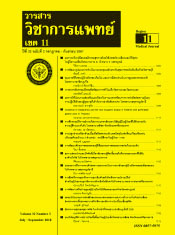Incidence of malignancy and the role of gastric biopsy in Patients with perforated gastric ulcer in Thailand.
Keywords:
Gastric ulcer perforation, Gastric cancer, Gastric biopsy.Abstract
Background: Perforated gastric ulcer is one of the most common diseases that require emergency surgery. The main etiologyof perforation is benign ulcer but malignant ulcer is found in 6 – 14% of cases and difficult to be preoper¬atively diagnosed. Then routine gastric biopsy is recommended. But difference in behavior, characters, and etiology of gastric ulcer in Thai patient raise the question of the real incidence of gastric malignancy and the role of gastric biopsy in Thai patients.
Objectives: To determine the incidence of gastric malignancy and to explore the associated risk factors in the patients with perforated gastric ulcer, and to assess the role of gastric biopsy in the patient with gastric ulcer perforation at Suratthani hospital, Thailand.Methods: A retrospective study was conducted by reviewing medical records from all 225 patients who were diagnosed of perforated gastric ulcer during January 1st, 2011 to December 30th, 2017 in Suratthani hospital. The 178 records which had sufficient data were enrolled into the study.Results: The incidence of malignancy in perforated gastric ulcer was 2.8% (5 of 178 patients). Two statistical significant factors that associated to malignancy were gross appearance of ulcer (OR 20.6, p<0.05) and the location of ulcer. The gross appearance of ulcer which associated to malignancy were chronic ulcer (8.8%, 3 of 34 patients) and mass like lesion (66%, 2 of 3 patients). None of 147 acute ulcers was malignancy. The ulcers that located at non-prepyloric area were significant associated to malignancy (OR 18.5, p<0.05).Conclusion: The incidence of malignancy in perforated gastric ulcer was very low in this study. Two statistical significant factors that associated to malignancy were gross appearance andlocation of ulcer. Gastric biopsy maybe not necessary in acute ulcer that located at pre-pyloric area
References
C.suriya,diagnosis indicators for pepticulcer perforation at a tertiary care hos-pital in thailand
Ergul E, Gozetlik EO. Emergency spon-taneous gastric perforations: ulcusversus cancer. Langenbecks Arch Surg 2009; 394(4):643e6.
Wysocki A, Budzynski P, Kulawik J,Drozdz W. Changes in the localization of perforated peptic ulcer and its relation to gender and age of the patients throughout the last 45 years. World J Surg 2011; 35(4):811e6.
Lehnert T, Buhl K, Dueck M, Hinz U,Herfarth C. Two-stage radical gastrectomy for perforated gastric cancer. Eur J Surg Oncol 2000; 26(8):780e4.
McGee GS, Sawyers JL. Perforated gastric ulcers. A plea for management by primary gastric resection. Arch Surg 1987; 122(5):555e61.
Adachi Y, Aramaki M, Shiraishi N, Shimoda K, Yasuda K, Kitano S. Long-term survival after perforation of advanced gastric cancer: Case report and review of the literature. Gastric Cancer 1998;1(1):80-3.
Courtney M, Townsend R, Daniel B,Mark E,Kenneth L. Sabiston textbook of surgery 20th edition. Philadelphia:
Elsevier; 2017.
Charles B, Dana K, Timothy R, David L, John G, Jeffrey B, Raphael E.Schwartz textbook of surgery 10th edition.Los Angelis: McGraw-Hill Education /Medical; 2014.
David W McFadden, John H. Pemberton,Shackelfords Surgery of the Alimentary Tract 7th edition. Saunders; 2012.
Matthew Fraser Leeman, Christos Skouras, Simon Paterson-Brown. The management of perforated gastric
perforation at a tertiary care hospital in Thailand. Clinical and Experimental Gastroenterology 2011:4 283–289.
Prof. Kjetil Søreide, MD, Mr. Kenneth Thorsen, MD, Mr. Ewen M. Harrison,MB, ChB, Prof. Juliane Bingener, MD,Mr. Morten H. Møller, MD. Perforated peptic ulcer. Lancet. 2015 Sep 26;386(10000): 1288–1298. doi: 10.1016/S0140-6736(15)00276-7
Satoh K, Yoshino J, Akamatsu T, Itoh T, Kato M, Kamada T. Evidence-based clinical practice guidelines for peptic ulcer disease 2015. J Gastroenterol.2016 Mar; 51(3):177-94. doi: 10.1007/s00535-016-1166-4.
Wilairatana S1, Kladchareon N, Israsena S, Wilairatana P. Epidemiology of peptic ulcer disease in Thailand.
Gastroenterol Jpn. 1991 Jul;26 Suppl 3:265-6.
Tantrachoti P, Werawatganon D,Soontornmanokul T, Rerknimitr R,Gonlachanvit S. Epidemiological Study
of Helicobacter pylori Infection and Endoscopic Findings in Thailand Epidemiological Study of Helicobacter
pylori Infection and Endoscopic Findings in Thailand. THAI J GASTROENTEROL 2013; 110
Emre Ergul, Erdal Ozgur Gozetlik.Emergency spontaneous gastric perforation: ulcer versus cancer.
Langenbecks Arch Surg (2009) 394:643–646.
Chutikarn Suriya1 nongyao Kasatpibal2 Wipada Kunaviktikul2 Toranee Kayee3. Diagnostic indicators for peptic ulcerperforation at a tertiary care hospital in Thailand. Clinical and Experimental Gastroenterology 2011:4 283–289
Ozmen MM, Zulfikaroglu B, Kece C,Aslar AK, Ozalp N, Koc M. Factors influencing mortality in spontaneous
gastric tumor perforations. J Int Med Res 2002; 30(2):180-4.
Hata T, Sakata N, Kudoh K, Shibata C,Unno M. The best surgical approach for perforated gastric cancer: One-stage vs. two-stage gastrectomy. Gastric Cancer 2014; 17(3):578-87.
James Y. Colin W. Howden d David C. Metz e, Systematic Review of the Epidemiology of Complicated Peptic
Ulcer Disease: Incidence, Recurrence, Risk Factors and Mortality. Digestion 2011; 102–113.






